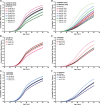Common variants associated with breast cancer in genome-wide association studies are modifiers of breast cancer risk in BRCA1 and BRCA2 mutation carriers
- PMID: 20418484
- PMCID: PMC2893806
- DOI: 10.1093/hmg/ddq174
Common variants associated with breast cancer in genome-wide association studies are modifiers of breast cancer risk in BRCA1 and BRCA2 mutation carriers
Abstract
Recent studies have identified single nucleotide polymorphisms (SNPs) that significantly modify breast cancer risk in BRCA1 and BRCA2 mutation carriers. Since these risk modifiers were originally identified as genetic risk factors for breast cancer in genome-wide association studies (GWASs), additional risk modifiers for BRCA1 and BRCA2 may be identified from promising signals discovered in breast cancer GWAS. A total of 350 SNPs identified as candidate breast cancer risk factors (P < 1 x 10(-3)) in two breast cancer GWAS studies were genotyped in 3451 BRCA1 and 2006 BRCA2 mutation carriers from nine centers. Associations with breast cancer risk were assessed using Cox models weighted for penetrance. Eight SNPs in BRCA1 carriers and 12 SNPs in BRCA2 carriers, representing an enrichment over the number expected, were significantly associated with breast cancer risk (P(trend) < 0.01). The minor alleles of rs6138178 in SNRPB and rs6602595 in CAMK1D displayed the strongest associations in BRCA1 carriers (HR = 0.78, 95% CI: 0.69-0.90, P(trend) = 3.6 x 10(-4) and HR = 1.25, 95% CI: 1.10-1.41, P(trend) = 4.2 x 10(-4)), whereas rs9393597 in LOC134997 and rs12652447 in FBXL7 showed the strongest associations in BRCA2 carriers (HR = 1.55, 95% CI: 1.25-1.92, P(trend) = 6 x 10(-5) and HR = 1.37, 95% CI: 1.16-1.62, P(trend) = 1.7 x 10(-4)). The magnitude and direction of the associations were consistent with the original GWAS. In subsequent risk assessment studies, the loci appeared to interact multiplicatively for breast cancer risk in BRCA1 and BRCA2 carriers. Promising candidate SNPs from GWAS were identified as modifiers of breast cancer risk in BRCA1 and BRCA2 carriers. Upon further validation, these SNPs together with other genetic and environmental factors may improve breast cancer risk assessment in these populations.
Figures


References
-
- Antoniou A., Pharoah P.D., Narod S., Risch H.A., Eyfjord J.E., Hopper J.L., Loman N., Olsson H., Johannsson O., Borg A., et al. Average risks of breast and ovarian cancer associated with BRCA1 or BRCA2 mutations detected in case series unselected for family history: a combined analysis of 22 studies. Am. J. Hum. Genet. 2003;72:1117–1130. doi:10.1086/375033. - DOI - PMC - PubMed
-
- Simchoni S., Friedman E., Kaufman B., Gershoni-Baruch R., Orr-Urtreger A., Kedar-Barnes I., Shiri-Sverdlov R., Dagan E., Tsabari S., Shohat M., et al. Familial clustering of site-specific cancer risks associated with BRCA1 and BRCA2 mutations in the Ashkenazi Jewish population. Proc. Natl Acad. Sci. USA. 2006;103:3770–3774. doi:10.1073/pnas.0511301103. - DOI - PMC - PubMed
-
- Rebbeck T.R. Inherited predisposition and breast cancer: modifiers of BRCA1/2-associated breast cancer risk. Environ. Mol. Mutagen. 2002;39:228–234. doi:10.1002/em.10050. - DOI - PubMed
-
- Antoniou A.C., Pharoah P.D., McMullan G., Day N.E., Stratton M.R., Peto J., Ponder B.J., Easton D.F. A comprehensive model for familial breast cancer incorporating BRCA1, BRCA2 and other genes. Br. J. Cancer. 2002;86:76–83. doi:10.1038/sj.bjc.6600008. - DOI - PMC - PubMed
-
- Antoniou A.C., Cunningham A.P., Peto J., Evans D.G., Lalloo F., Narod S.A., Risch H.A., Eyfjord J.E., Hopper J.L., Southey M.C., et al. The BOADICEA model of genetic susceptibility to breast and ovarian cancers: updates and extensions. Br. J. Cancer. 2008;98:1457–1466. doi:10.1038/sj.bjc.6604305. - DOI - PMC - PubMed
Publication types
MeSH terms
Grants and funding
LinkOut - more resources
Full Text Sources
Other Literature Sources
Medical
Miscellaneous

